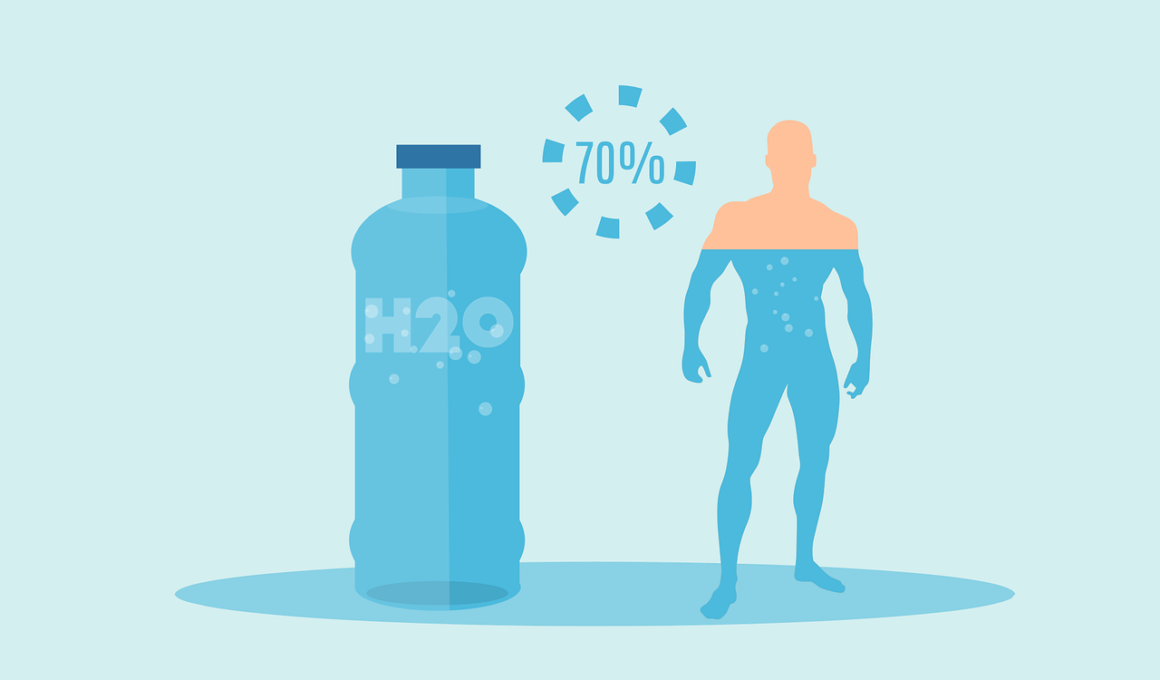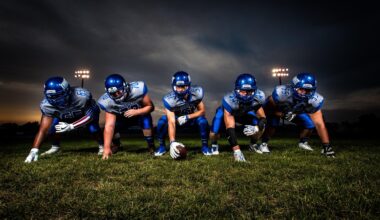Guidelines for Safe Hydration Before, During, and After Endurance Events
Hydration is a crucial part of preparing for endurance events. Athletes must ensure they are adequately hydrated before the event begins. This process begins well in advance, ideally several days prior to the event. Drinking water is vital, but electrolytes should also be considered, as they replenish essential minerals lost through sweat. Begin by increasing your daily fluid intake and incorporating sports drinks that contain sodium and potassium. Practical strategies include tracking fluid intake and setting hydration reminders. It’s beneficial to plan hydration for your training sessions, as this prepares your body for race conditions. Another essential tip is to monitor the color of your urine, where lighter shades indicate good hydration levels. Be aware of signs of dehydration such as headaches and fatigue. It’s also important not to over hydrate, which can lead to hyponatremia. Be sure to establish a hydration plan that suits your body type, weight, and environment. Always listen to your body’s signals and adjust your hydration strategy as needed. Adequate preparation is paramount to ensuring optimal performance during endurance events.
During the endurance event, maintaining hydration is vital for sustaining energy and performance. Plan your fluid intake based on the event’s duration, weather, and your own sweat rate. It’s recommended to drink small amounts of fluids consistently, rather than large quantities at once. For events lasting over an hour, incorporating electrolyte drinks can help maintain mineral balance. Set up aid stations or carry hydration packs to ensure access to water and sports drinks. A practical approach is to drink approximately every 15 to 20 minutes, but adjust according to conditions and personal thirst cues. Remember, excessive drinking can be counterproductive, leading to distension and discomfort. If participating in a longer race, familiarize yourself with the available hydration options along the route. Consider practicing with different beverages during training to see what works best for your body. Keep in mind that hydration needs can also change based on temperature and humidity levels. Always be on the lookout for signs of dehydration or overhydration. Learning to read your body will fine-tune your hydration strategy, ultimately enhancing performance and safety throughout the event.
Hydration After Endurance Events
Post-event hydration is equally significant for recovery and rejuvenation. Rehydration should begin immediately after crossing the finish line or completing your training session. Consuming fluids right away helps replace lost fluids and aids in muscle recovery. Sports drinks containing carbohydrates and electrolytes are particularly beneficial in this phase. Aim to consume at least 1.5 liters of water or electrolyte solutions for every kilogram of body weight lost during the event. Monitor urine color post-race to ensure proper hydration levels are achieved. Eating hydrating foods such as fruits and vegetables can also enhance recovery. Broth-based soups, smoothies, and yogurt are excellent post-event options that provide hydration and nutrients. Incorporating these can make recovery more enjoyable and nutritious. Remember to continue to hydrate over the next 24 hours, as muscle repair and recovery processes require adequate fluids. Avoid excessive caffeine or alcohol after your event, as these can contribute to dehydration. Setting hydration goals in the recovery phase can help ensure that you take in enough fluids for optimal recovery. A good hydration plan always includes awareness of your body’s feedback for effective results.
To enhance your hydration efforts, consider tracking your fluid intake effectively. Various applications and devices can assist in logging hydration levels throughout the day, especially leading into and after endurance events. Establish a habit of drinking at regular intervals, targeting a specific volume of intake based on your activity level. Use water bottles with measurements to simplify monitoring how much you’re consuming. This concept allows easier adjustments when feeling less motivated to drink enough. If you have difficulty consuming plain water, experiment with flavored options, herbal teas, and infusions to make hydration more appealing. Additionally, set prompts or alarms to remind you to hydrate, especially during long training sessions and races. Keep track of the weather, as environmental factors can significantly impact your hydration needs. Understanding your sweat rate is crucial; aim to measure it during training sessions to ascertain what will be required on race day. With proper planning, your hydration can be tailored to fit your specific needs, improving endurance and overall performance. Every individual has unique requirements to consider, adjusting strategies that fit personal preferences. Stay proactive on hydration to empower your endurance activities.
Utilizing Electrolytes Wisely
Understanding electrolytes and their role in hydration can significantly impact endurance performance. Electrolytes, such as sodium, potassium, calcium, and magnesium, help regulate fluid balance in the body. During endurance events, you lose these critical minerals through sweat, making electrolyte replenishment essential. Athletes must find a balance between consuming sports drinks and plain water, ensuring they do not solely rely on one source. Read labels carefully; many drinks contain sugars that can impart unnecessary calories. A practical solution is to try electrolyte tablets or powders, allowing for custom blends suited to your needs. In training, determine what electrolyte levels work best for your body and environment. Drinking an electrolyte beverage before, during, and after endurance events will maintain performance and prevent cramps. Be vigilant for symptoms of electrolyte imbalances, such as muscle cramps or dizziness, which indicate a need for replenishment. Understanding when and how to incorporate these into your hydration strategy will contribute to a smoother performance. Remember that factors like training intensity, duration, and temperature greatly influence electrolyte needs. Customize your electrolyte strategy tailored to individual and environmental factors to optimize endurance performance.
The environment can significantly affect hydration strategy, making awareness essential. Weather conditions like heat and humidity exacerbate fluid loss during endurance events, leading to an increased need for hydration. Pay special attention to the forecast before your events and adjust your hydration intake accordingly. On hot days, increase your pre-event fluid intake by drinking additional water and electrolytes. Consider scheduling breaks to hydrate during races, especially if temperatures soar. In cooler conditions, body fluids lose rapidly despite not feeling thirsty. Understand that cold, dry air may lead to dehydration, so consistent hydration is still necessary. Hydration should also be adjusted based on altitude, as higher elevations can accelerate fluid loss. Testing your hydration strategy in various weather conditions during training prepares you for race day. Establishing a comprehensive hydration plan that considers temperature, duration, and environment is vital. Rely on experience and body signals to help you tweak your strategies. Always prioritize listening to your body’s needs and understanding how it reacts differently in varying conditions for effective hydration management. Taking these factors into account will vastly improve your endurance training and event performance.
In summary, effective hydration before, during, and after endurance events is crucial for peak performance and safety. Developing a personalized hydration plan allows athletes to prepare for their events intelligently. Begin with solid preparation that includes pre-event hydration strategies, keeping a keen eye on electrolyte balance, and establishing regular water intake schedules. During events, adapt your hydration intake based on weather and duration while incorporating electrolyte sources appropriately. Post-event hydration sets the stage for recovery, with continued fluid intake enhancing muscle replenishment. Monitoring factors like sweat loss, climate, and individual preferences ensures a refined approach for endurance challenges. Leveraging technology for hydration tracking or consulting professionals can enhance clarity in setting a hydration strategy. Knowledge of environmental impacts and how they affect hydration should guide athletes in making the right choices. Ultimately, a comprehensive understanding of the principles surrounding hydration will lead to better performances, faster recovery, and a successful endurance experience. Make hydration a non-negotiable aspect of your training for long-term athletic success, ensuring both performance optimization and health.
In conclusion, never underestimate the importance of hydration in endurance training and events. With deliberate attention to fluid intake, athletes can maintain their performance levels while safeguarding their health. Balancing water and electrolytes, constantly monitoring intake, and adapting based on environmental factors will create a successful hydration strategy. Education and awareness can make a significant difference, allowing athletes to perform better and recover faster. Keeping an open dialogue with coaches and nutritionists also aids in perfecting hydration approaches. Remember, effective hydration is a skill that can be honed over time. Commit to learning and improving your hydration methods consistently.


